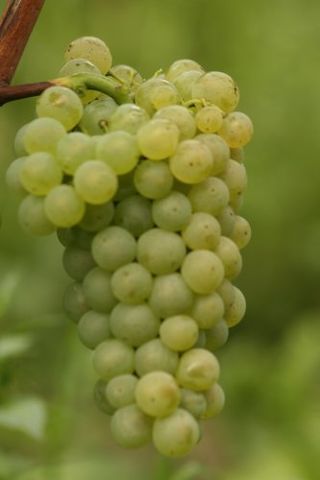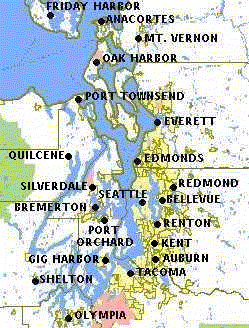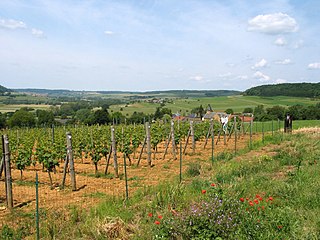
Aurore is a white complex hybrid grape variety produced by Albert Seibel and used for wine production mostly in the United States and Canada. Over a long lifetime Seibel produced many complex hybrid crosses of Vitis vinifera to American grapes. It is a cross of Seibel 788 and Seibel 29.

Gewürztraminer is an aromatic wine grape variety, used in white wines, and which performs best in cooler climates. In English, it is sometimes referred to colloquially as Gewürz. In English and French it is usually written Gewurztraminer. Gewürztraminer is a variety with a pink to red skin colour, which makes it a "white wine grape" as opposed to the blue to black-skinned varieties commonly referred to as "red wine grapes". The variety has high natural sugar and the wines are white and usually off-dry, with a flamboyant bouquet of lychees. Indeed, Gewürztraminer and lychees share the same aroma compounds. Dry Gewürztraminers may also have aromas of roses, passion fruit and floral notes. It is not uncommon to notice some spritz.

Saale-Unstrut is a region (Anbaugebiet) for quality wine in Germany, and takes its name from the rivers Saale and Unstrut. The region is located on various hill slopes around these rivers. Most of the region's 685 hectares under vine in 2008 is situated in the federal state of Saxony-Anhalt, with around 20 hectares in the state of Thuringia.

Müller-Thurgau is a white grape variety which was created by Hermann Müller from the Swiss Canton of Thurgau in 1882 at the Geisenheim Grape Breeding Institute in Germany. It is a crossing of Riesling with Madeleine Royale. It is used to make white wine in Germany, Austria, Northern Italy, Hungary, England, Australia, the Czech Republic, Slovakia, Slovenia, New Zealand, Canada, the United States, Belgium and Japan. There are around 22,201 hectares ) cultivated worldwide, which makes Müller-Thurgau the most widely planted of the so-called "new breeds" of grape varieties created since the late 19th century. Although plantings have decreased significantly since the 1980s, as of 2019 it was still Germany's second most planted variety at 11,400 hectares and 11.4% of the total vineyard surface. In 2007, the 125th anniversary was celebrated at the Geisenheim Grape Breeding Institute. Müller-Thurgau is also known as Rivaner, Riesling x Sylvaner, Riesling-Sylvaner, Rizvanec (Slovenia) and Rizlingszilváni (Hungary).

Scheurebe or Sämling 88 is a white wine grape variety. It is primarily grown in Germany and Austria, where it often is called Sämling 88, and some parts of the New World. Scheurebe wines are highly aromatic, and the variety is often used for sweet wines, although dry Scheurebe wines have become more common in Germany.

Huxelrebe is a white grape used for wine. Huxelrebe is primarily found in Germany, where the cultivated area covered 396 hectares in 2019, with a decreasing trend. It is primarily found in the German wine regions Rheinhessen, Palatinate and Nahe. Small plantations are also found in England.

Regent is a dark-skinned inter-specific hybrid grape variety, used for making wine. It has both European and American vine species in its pedigree and a broad resistance against the most significant fungal diseases which affect grapes, such as downy mildew.

Madeleine Angevine is a white wine grape from the Loire Valley in France that is also popular in Germany, Kyrgyzstan and Washington state. The early-ripening grape is a cross between Madeleine Royale and Malingre Précoce grapes that grows well in cooler climates. Madeleine Angevine makes an attractive fruity wine with a flowery nose, similar to an Alsatian Pinot blanc. It is crisp, acid and dry and pairs particularly well with seafoods such as crab and oyster.

The Puget Sound AVA is an American Viticultural Area in western Washington State. It is the only AVA in the state of Washington that is located west of the Cascade Mountains.

Faberrebe or Faber is a grape variety used for white wine. It was created in 1929 by Georg Scheu at the Landesanstalt für Rebenzüchtung in Alzey and was released with varietal protection in 1967. Scheu created Faberrebe by crossing Pinot blanc and Müller-Thurgau.

Domina is a dark-skinned variety of grape used for red wine. It was created by German viticulturalist Peter Morio at the Geilweilerhof Institute for Grape Breeding in the Palatinate in 1927 by crossing the varieties Blauer Portugieser and Pinot noir.

Freisamer is a white German wine grape variety grown primarily in the Baden region with some plantings in eastern and western Switzerland. The variety was created in 1916 by Karl Müller at the Staatliches Weinbauinstitut in Freiburg im Breisgau, Germany by crossing Pinot gris and Silvaner. The purpose of the crossing was to find an improved variety similar to Pinot gris. The name is a contraction of Freiburg and Dreisam, the river that runs through Freiburg.

Helfensteiner is a dark-skinned German wine grape crossing of the species Vitis vinifera, that was created in 1931 with the crossing of Frühburgunder and Trollinger. It was created by August Herold at the grape breeding institute in Weinsberg in the Württemberg region.

Heroldrebe is a red German wine grape variety produced by crossing Blauer Portugieser and Lemberger. It was created by August Herold at the grape breeding institute in Weinsberg in the Württemberg region in 1929, and was named after him.

Belgian wine is produced in several parts of Belgium and production, although still modest at 1,400 hectoliters in 2004, has expanded in recent decades.

Goldriesling is a grape variety of the species Vitis vinifera used for white wine. It was created in 1893 by Christian Oberlin in Colmar, Alsace by crossing Riesling with another grape variety, which is sometimes given as Courtillier Musqué Précoce, but not identified conclusively.

Phoenix is a white variety of grape of German origin used for wine. It was created by Dr. Gerhardt Alleweldt (1927–2005) at the Geilweilerhof Institute for Grape Breeding in Siebeldingen in 1964, by crossing the Vitis vinifera variety Bacchus with the hybrid grape Villard Blanc.

Incrocio Manzoni or Manzoni grapes is a family of grape varieties named after Professor Luigi Manzoni (1888-1968) of Italy's oldest school of oenology located in Conegliano, in the Veneto region. Manzoni created the new grape varieties by selecting, crossing and grafting vines from various vineyards during the 1920s and 1930s. The family includes both white and red grape varieties. Although most Manzonis are grown in northeastern Italy, they are mainly grown in the Piave area of Province of Treviso and are only now starting to be sold commercially in Europe and the United States.
Enfariné noir is a red French wine grape variety that is grown predominantly in the Jura wine region of eastern France. Despite being known under the synonym Gouais noir in the Aisne, Aube, Marne, Meuse and Seine-et-Marne departments, the grape has no known connection to the Gouais blanc wine grape that is the parent of several wine grape varieties such as Chardonnay, Gamay and Melon de Bourgogne. While once widely planted throughout the Franche-Comté, the grape is now nearly extinct with less than 1 hectare of the variety planted in 2008.
Georg Scheu, was a German botanist, plant physiologist, oenologist and grape breeder.



















